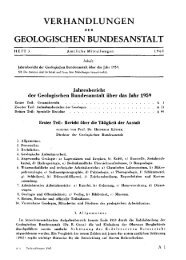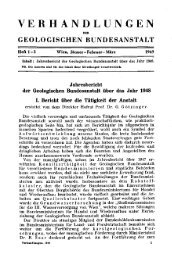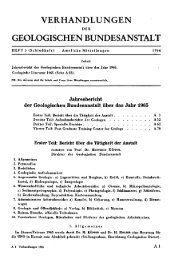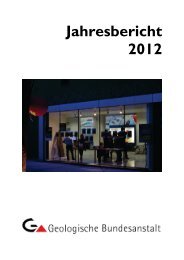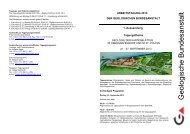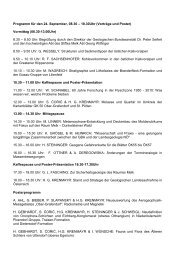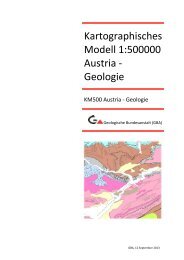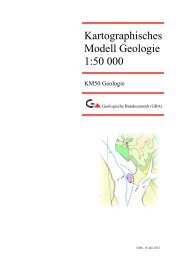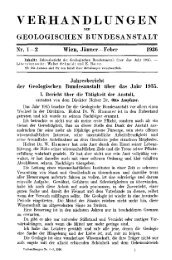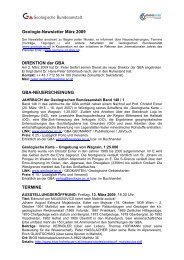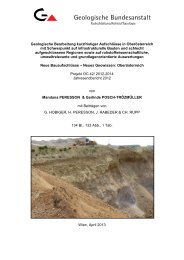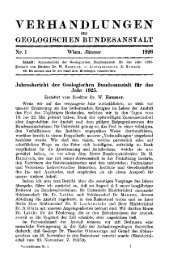Field Trip B TRIASSIC CONODONT LOCALITIES OF THE ...
Field Trip B TRIASSIC CONODONT LOCALITIES OF THE ...
Field Trip B TRIASSIC CONODONT LOCALITIES OF THE ...
You also want an ePaper? Increase the reach of your titles
YUMPU automatically turns print PDFs into web optimized ePapers that Google loves.
Lithostratigraphy<br />
A comprehensive study on lithology, thickness and petrology of the Hallstatt Limestone of the Salzkammergut<br />
region was carried out by SCHLAGER 1969. According to him the Hallstatt sequence can<br />
be divided into five major parts each characterized by distinct lithologic features. All types of Hallstatt<br />
Lst. will be shown during the excursion to Feuerkogel and Sommeraukogel. The following summary<br />
mainly follows SCHLAGER 1969, p. 293, with amendments made by the author.<br />
„Grauvioletter Bankkalk" (= greyish-violet bedded 1st.):<br />
Well bedded to nodular bedded, 10 to 20 cm thick microsparitic to pelsparitic, in part siliceous limestone<br />
beds. At its base chert nodules may frequently occur. Colour and the brittle fracture are distinct<br />
features of this type which hardly can be mixed with any other limestone type.<br />
„Roter Knollenflaserkalk" (= red nodular Flaser-limestone):<br />
Reddish and regularly bedded, nodular Flaser-limestone consisting of 10 to 30 cm thick beds separated<br />
by thin marly partings. In terms of microfacies this limestone is a biomicrite with bivalves and radiolarians<br />
as main constituents of the fauna. Formation of nodules and flaser structure is explained by<br />
pressure solution during an early diagenetic stage.<br />
„Roter Bankkalk" (= red bedded limestone):<br />
Reddish to pink coloured biomicritic limestone with strong bioturbation causing mottled and irregular<br />
structures. Beds are 20 to 50 cm thick and well bedded. Individual beds are mostly homogenous<br />
but locally interstratal reworking can be found. Particularly at Feuerkogel subsolution patterns with<br />
Fe-Mn crusts are frequently. In the upper part lateral changes may occur within short distances. The<br />
transition to the overlying massive „Hellkalk" is gradually; locally an alternation between both types<br />
occur.<br />
„Massiger Hellkalk" (= massive light limestone):<br />
Irregularly thick bedded to massive micritic limestone. Colour predominantly white or grey, yellowish<br />
or pink. Another characteristic feature is the great thickness. First reports on this rock were published<br />
by MOJSISOVICS 1905 from Raschberg („Wandkalk") and from Sommeraukogel.<br />
„Hangendrotkalk" (= upper red limestone):<br />
Platy to nodular bedded biomicritic limestone with mostly strong bioturbation pattern. Locally flaser-structure<br />
can be found but this feature is less dominating than in the „Knollenflaserkalk". Subsolution<br />
patterns occur frequently, in particular at Sommeraukogel (thinning of individual beds in the direction<br />
of a submarine ridge). The so-called „Hangendgraukalk" is regarded as a lateral equivalent of<br />
the „Hangendrotkalk"; apart from the colour, this type is also more argillaceous. It replaces the Upper<br />
Norian portion of the „Hangendrotkalk" at Steinbergkogel near Hallstatt.<br />
Upper Triassic ammonoid and conodont time scales (fig. 5)<br />
Ammonoid zonation (fig. 5)<br />
Since publication of TOZER's ammonoid zonation in „Standard of Triassic Time" more than 10<br />
years have gone and his zonal scheme which originally was established for North America has been successfully<br />
applied in various parts of the world. Different from North America in the meantime, however,<br />
new biostratigraphic studies have been carried out particularily in Europe and Asia (KRYSTYN<br />
1978, TATZREITER 1978, KRYSTYN in press) which have provided more detailed data for a refinement<br />
of the ammonoid based subdivision of the Triassic system.<br />
The major object of these studies is a subdivision of the currently used zonal concept into smaller<br />
intervals, for example, mto subzones which are regarded as biozones. Such a biozone is defined by the<br />
total liefe span (= range zone) of a certain index species on a world wide scale. However, in many regions<br />
our present knowledge about distribution and ranges of Triassic ammonoids does not favour this<br />
theoretical consideration. Particularily in the Upper Karnian and Lower Norian no subdivision into subzones<br />
exists which is, for example, comparable to that of the Jurassic (see MOUTERDE 1971, UR-<br />
LICHS 1977). Hence, presently the corresponding index ammonoids are supposed to represent the best<br />
and most diagnostic species for Upper Karnian and Lower Norian times.<br />
It is interesting to note that almost all of the new faunal subdivisions have been established in the<br />
Hallstatt Limestone of different regions in the Tethys realm (Alps, Greece, Turkey, Timor). The Hallstatt<br />
facies bears the richest ammonoid faunas of the Triassic but its successions normally are very re-<br />
71



